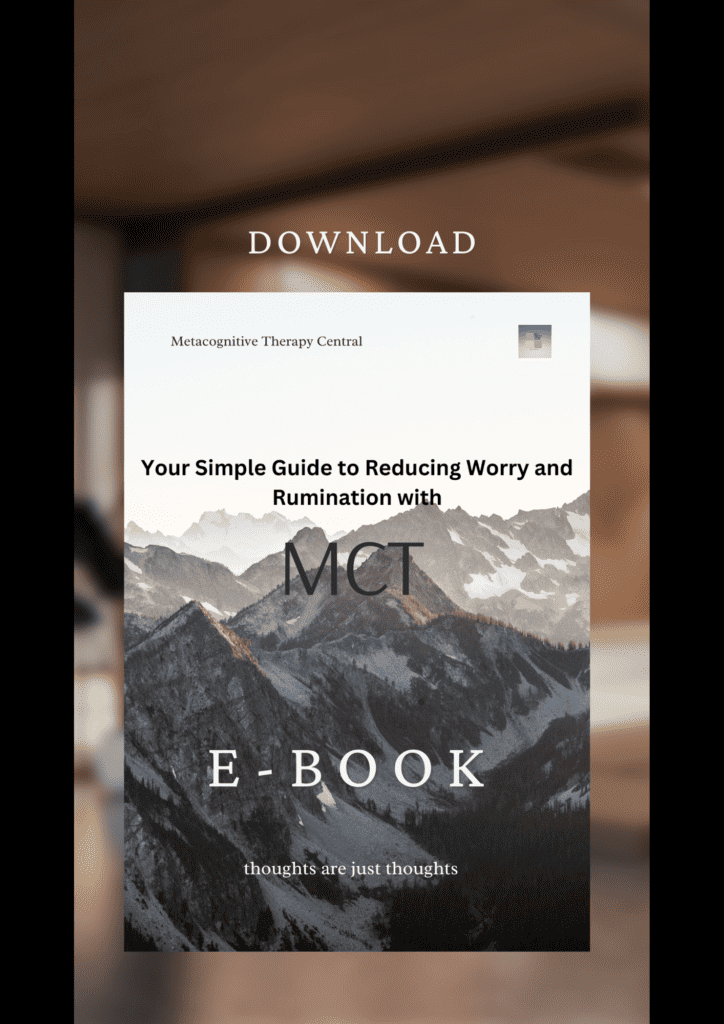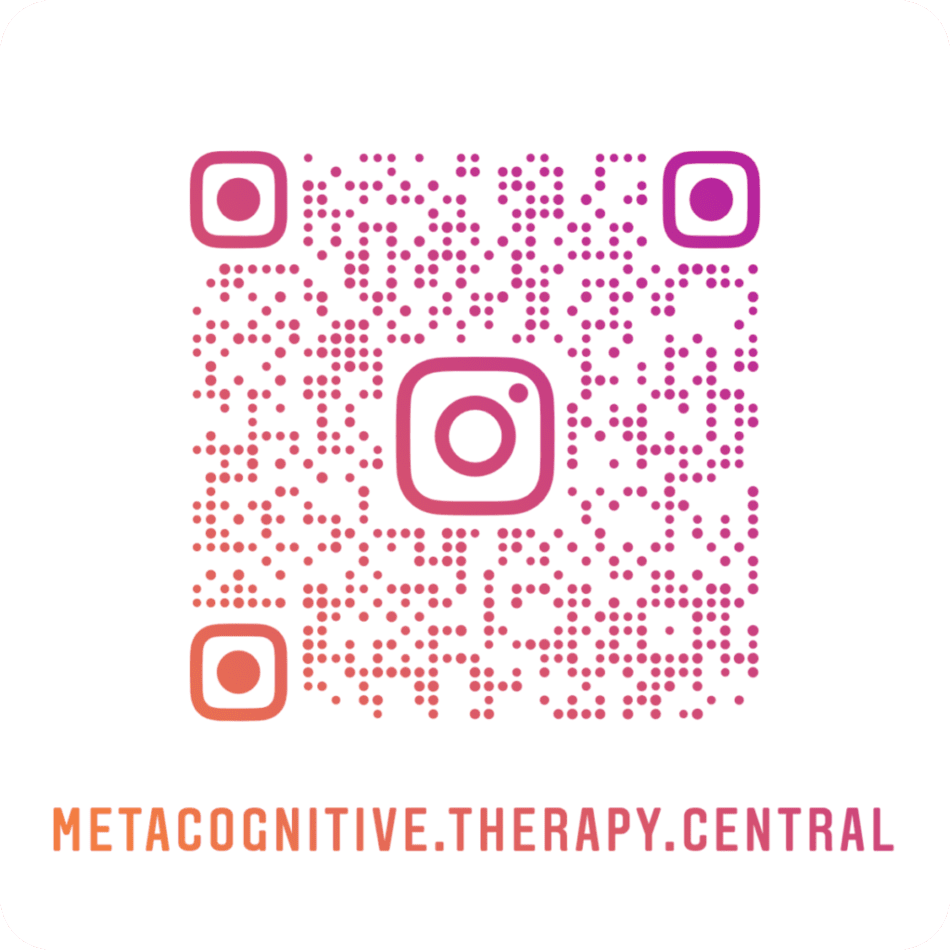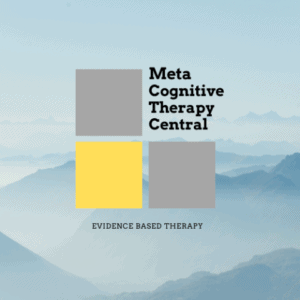
If you are dealing with anxiety, depression, OCD, or low self-esteem, there is a good chance you are spending a lot of time either worrying/analyzing, trying to push away unwanted thoughts, or keeping yourself distracted to avoid them.
According to the theory behind Metacognitive Therapy (MCT), the strategies you use to handle thoughts actually contribute to feeling bad in the long run. That is why the MCT tools, designed to tackle mental illness, require a completely different approach to dealing with unwanted thoughts and emotions.
Metacognitive therapy includes helpful strategies like detached mindfulness (letting thoughts be), worry postponement (putting off worrying for later), and attention training technique (learning to control what you pay attention to).
But here is the catch, these are not tools. These are strategies. Typically, tools are what we use to solve problems and make them go away. However, with MCT the aim isn’t to make unwanted thoughts disappear but to develop a different relationship with them. By applying a different strategy. This is what makes MCT both a bit challenging to understand at first and genuinely extraordinary.
Metacognitive therapy tools are developed to help you have a relaxed relationship with unwanted thoughts and emotions
| Metacognitive therapy strategy | What does it work for | How is it used in therapy |
| Worry postponement (to postpone worrying about a problem for later) | To reduce excessive worrying about your thoughts so your mind can get a break to self-regulate | The therapist asks you to choose a specific time during the day as a designated “worry time” and encourages you to postpone all worrying/analyzing problems for that time. |
| Attention training (to move attention around intentionally) | To break away from extreme self-focus and rumination. And to rediscover how much control you actually have over your attention. | The therapist introduces an attention training technique in the session or teaches you to refocus attention back to a specific thing (a listening or reading assignment, a conversation, or work) every time you get distracted by thoughts |
| Detached mindfulness (to leave thoughts alone) | To see thoughts for that they are, just thoughts and not facts. To reduce hours of worrying/ruminating about thoughts because that makes you miserable. | The therapist will use metaphors to teach you to leave unwanted thoughts be. At first you will practice leaving neutral thoughts alone, for example, a white bear, and then progress to leaving your negative thoughts alone. |
Metacognitive therapy “tools”
As a practicing clinical psychologist, I work only with MCT. Therefore, when a client starts treatment, my most important role is the following:
- To help my client identify the thoughts that trigger them to start worrying/analyzing for hours
- To help them understand that worrying/analyzing doesn’t solve their problems (but makes matters worse)
- To teach them to stop worrying/analyzing or at least reduce it so much so that it won’t affect their psychological well-being. And this is when the MCT strategies come in handy.
So let’s go over each one and see how they are used.
In MCT, we use the term “trigger thought” for thoughts that trigger us to start worrying.
A triggering situation
Imagine that you need to focus on important work or study for an exam, but distracting thoughts like “What if I fail?” or “Can I finish on time?” keep popping up. The thing to remember is that worrying is an act you choose to do when these thoughts appear.
Rather than concentrating on the task at hand, you find yourself caught up in these worries, which creates a cycle where your ability to focus becomes a concern: “I’m too stupid, that’s why I can’t do this” or “Why is it so hard to focus?“
In a situation like this, there are a number of things you can do:
1. Worry postponement
Instead of worrying about these thoughts and ending up losing focus, you decide to postpone worrying about these thoughts for your worry time at 6 PM.
So you tell yourself: There is a trigger thought about failing. I am not going to waste my time worrying about this right now but will do that later in my worry time.
2. Detached mindfulness
As you decide to postpone worrying about these thoughts for later, you naturally leave them alone. Leaving thoughts alone means that you let the thought exist in your mind, but decide not to react more to it. You leave the thought alone (See the metaphors below to help you better understand detached mindfulness).
3. Attention training/shifting focus
Now that you have decided not to respond to your thoughts with worrying, you move your attention outward (away from the thoughts in your mind and out on the work you were doing). You refocus your attention back on the task at hand whenever you get distracted by the thoughts (which will happen many times).
“Thoughts don’t matter but your response to them does” – Adrian Wells, founder of Metacognitive therapy
The goal of using Metacognitive therapy strategies
As you can tell from the example above, all three strategies help you respond differently to the initial trigger thoughts. The goal of using them is so that you don’t get caught up in hours of worrying/ruminating which can make you feel anxious, tense, and unable to concentrate on important things in your life.
You can use the above strategies when notice that you are worrying about/analyzing your thoughts without getting anywhere except feeling down, sad, or anxious.

Should you use Metacognitive therapy strategies?
| Use detached mindfulness/worry postponement/attention training |
| To get an idea of what it’s like to respond to thoughts in a different way |
| To reduce worrying/rumination if you have a tendency to do this |
| To start developing a relaxed relationship with negative thoughts |
These strategies are developed as part of Metacognitive therapy. In therapy, they are used to reduce excessive worrying/rumination AND to challenge specific ideas people have about their thinking.
For example, most people with anxiety believe that they can’t stop worrying. So by learning detached mindfulness and applying it to trigger thoughts, they gain confidence in their ability to control worry/rumination.
However, these tools are not meant to be used as coping tools to make thoughts and unwanted emotions to go away.
Ideally, you should learn these strategies through the help of a skilled MCT therapist. This is especially important if you are suffering from anxiety disorder, depression, or obsessive-compulsive disorder.
In my experience, when people aren’t familiar with the idea behind Metacognitive therapy (which is to make space for healthy self-regulation and learn to control worry), they end up misusing detached mindfulness and attention training to make thoughts go away and to feel calm. Unfortunately, this only works short term and prevents them from experiencing the important benefits ( like no longer fearing negative thoughts and emotions).
You can still try to apply these strategies to your trigger thoughts but make sure you do that with the right goal.
Five metaphors to help you practice
Sometimes, when we are dealing with stuff inside our minds like thoughts and emotions, things can get a bit confusing. Because what does it really mean not to respond to thoughts? I use some of the below metaphors to help my clients understand better.
Pick one that makes sense to you and use it as a reminder for what to do when you have trigger thoughts you don’t want to worry about or suppress.
The running sushi
Imagine your thoughts like small plates on a conveyor belt in a sushi restaurant. They come and go, just like thoughts appearing and disappearing. It’s up to you – you can decide to grab those thought-plates or simply let them pass by. Even if they come back later, you still have the choice not to pick them up.

The fish hook
Think of trigger thoughts like fish hooks, and you’re a fish swimming in the water. You can’t control how many hooks you encounter, but you get to decide whether to swim past them or take the bait. It is impossible to avoid negative thoughts in life, and there will be times you take the bait, worrying and analyzing. But, you can still choose to unhook yourself and swim past those hooks.

Clouds in the sky
Think of thoughts as clouds in the sky. Just like clouds are part of the self-regulated weather system, thoughts come and go naturally. You can’t control them, and trying to push them away or worry about them is not necessary or helpful. The best approach is to let thoughts have their own space, allowing them to come and go. Try applying the same idea to your negative thoughts and feelings.

Observe an apple
Close your eyes and picture an apple. Look at the image without altering it. No need to make it perfect or look a certain way. Stick with the first image that comes to mind. Keep focusing on the apple and see what happens. If the image shifts to something else, let it happen and keep watching. Can you have a thought about an apple without getting involved? Now, try the same with one of your trigger thoughts.

The radio
Picture your thoughts and feelings like a not-so-great radio show you can’t switch off. Instead of giving it all your attention, shift your focus to something outside your head. Let the radio chatter on while you do the dishes, cook dinner, or chat with a friend. You can have negative thoughts without getting tangled up in them and carry on with your day.

Remember to be persistent. Reducing worry/rumination is like changing an old habit. It takes repetition and time, but you will get there.
Free MCT E-book
Organize your MCT exercises and learn how to use them to reduce worry and rumination. Download the free e-book here.

What should you do going forward?
It is normal to worry about and analyze our thoughts. Many people worry about topics like health, the future, relationships, finances, and appearance. Many of my clients also analyze their moods, symptoms, their past, and their self-worth.
But, although it is normal to worry and ruminate, we can quickly worry ourselves into feeling down or become very anxious.
This cycle of constant worry leads to strong feelings of nervousness, anxiety, and physical symptoms, which psychologists label as an anxiety disorder. If you keep ruminating on things for too long, it can lead to feelings of sadness, emptiness, hopelessness, and, eventually, depression.
So although worrying/ruminating is normal and harmless, spending too much time doing it can cause mental suffering.
If that is the case for you, you can benefit from leaving your trigger thoughts alone and stop worrying/ruminating about them. Metacognitive therapy is a very effective therapy to help you overcome anxiety and depression.
Use the strategies outlined in this post as a starting point to get an idea of Metacognitive therapy. But make sure to consult an MCT-I certified therapist if you suffer from severe anxiety or depression and learn to use MCT correctly.
Where can I receive Metacognitive Therapy?
If you have difficulty managing worry and rumination or suffer from anxiety, depression, or OCD you can book a free intro session here and discuss how MCT can help you recover.

References
- Wells, A. (2009). Metacognitive therapy for anxiety and depression. Guilford Press.
- Wells, A., & Matthews, G. (1994). Attention and emotion: A clinical perspective. Lawrence Erlbaum Associates, Inc.
